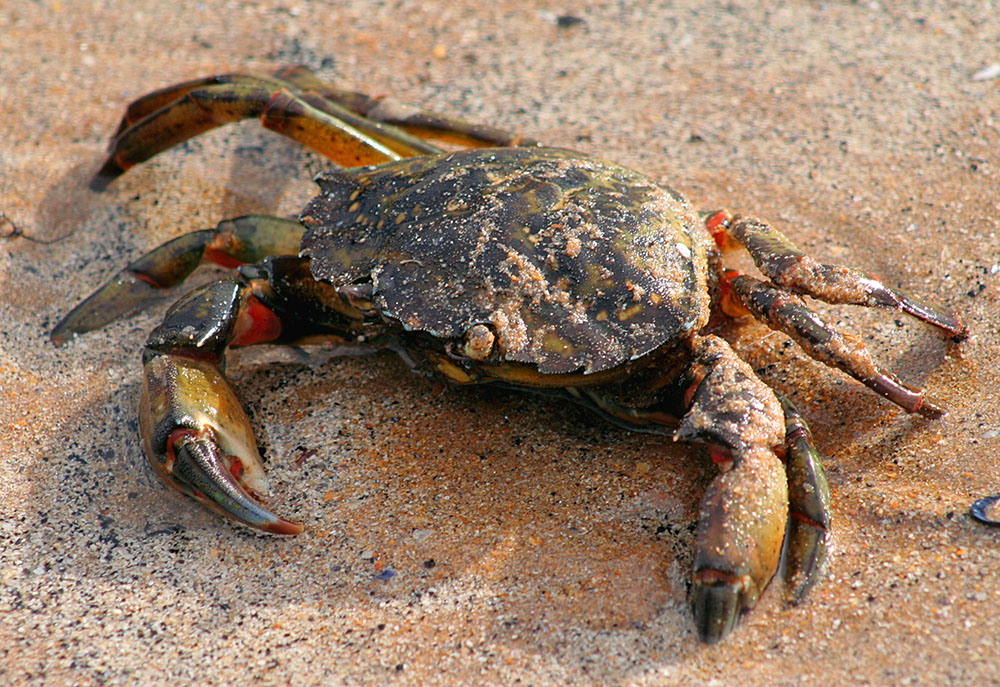
(Wikimedia Commons/John Haslam)
Poetry helps us to locate ourselves in the world, and Mark Doty's "A Green Crab's Shell" is a road map to the infinite within us.
The poem begins by contradicting itself, in the first line admitting: "Not, exactly, green: / closer to bronze." Contradiction can elegantly hold truths that often are messy and not easily sorted, immediately erasing the idea that someone or anything can be pure. With this primary contradictory line, Doty invites us to look further at the creature captivating him.
"A Green Crab's Shell" is made of 13 tercets, a poetic word for a stanza (or section) of three lines. The first eight tercets of the poem describe the dead green crab's shell, with a pinhole focus on the body: its legs, the shape of its pinchers, the likeness of its colors. We learn that the crab's body was "oddly muscular," its legs "complexly folded," and its center "gobbled" through by a gull.
Doty's use of two-word phrases delight the poem, and indicate to the reader that while it's the crab that's being written about, something deeper is at play. Phrases like "brilliant rinse," "summer's firmament," "lavish lining" and "scuttling works" adorn the crab with a kind of awe and honor.
It would be easy for a poet to say something like, "I saw a beautiful crab shell," but it's much harder to recognize something plain as a piece of God.
Advertisement
Perhaps it is the poet's intent to conflate the ordinary with the holy. The placement of the word "works" within the poem ("works / of armament, crowned") suggests that the crab's legs are a kind of artwork, art being the expression of energy passing through the artist's body, energy that's within and without the world.
We're presented with another contradiction, that this armored, menacing crab was eaten into. The crab's center — and life — taken by another creature to fuel its own. But loss gives way to revelation.
We reach the midpoint of the poem. The crab's center is also the center of the poem's meaning: It's blue and shocking and small and wonderful. Its empty chest is a surprise that gives way to wonder. This is where, of course, God lives.
The chamber is small, according to the poet, no larger than a small coffee cup. It's a small purse, smelling of "seaweed and ruin." Blue on the inside, and not just any blue, but "Giotto blue," a reference to the father of Renaissance painting. Giotto was the man who drew a perfect circle.
The color blue has long captivated artists of all kinds — writers, painters, sculptures. Perhaps because it's a color that, like an ocean's waves, seduces and releases us, just before we feel we're about to understand it. It is the color of vastness and expanse. It is the color of the world.
Another way of interpreting the Jewish phrase tikkun olam — "to repair the world" — could be to repair "all time," the "everlasting" or what’s "beyond the horizon." It is a call to repair what we can't see, to believe in the virtue of the unknowable, and to understand the world not just as a home or a planet, but as a kind of ecological clock.
What if there were a universe inside each of us living things? What if we could recognize it?
While most of us understand clocks as a way to track time and arrange our days, the ecology of the Earth knows no such operations: There are cycles of birth, decay and death. There are creatures and plants that tend to one another. There are days that bring destructive weather and seasons that suggest change.
Most importantly, there is a stillness to this definition of time, a beingness and a second revelation: that time moves through us. The Earth's rapidly changing ecosystems and negative feedback loops have revealed that to attempt to master time is an unkind ruse. You can't hold the world in your hand. But you can hold what a crab left behind.
The poem picks up speed in the last five stanzas, almost as if it begins to understand what its own existence is about. "Imagine breathing / surrounded by / the brilliant rinse / of summer's firmament," the poem reads, invoking the word that describes the task of world creation in Genesis when God split the sea to build dry land. Both seas, the one below and the one above, are blue. As is the crab's small chamber — that shocking Giotto blue.
The speaker, at this point, wonders about God's human creation, who can live in neither the ocean nor the sky. He seems to realize humans are no different than the crab who owned a shell he now holds.
"What color is / the underside of skin?" The question goes unanswered by the poet, but I wonder, what if it were blue? What if the underside of skin were the color of God's vast sky or relentless, deep ocean? What if there were a universe inside each of us living things? What if we could recognize it?
The ending lines are better than an answer: "Not so bad, to die / if we could be opened / into this — / if the smallest chambers / of ourselves, / similarly, / revealed some sky."
I love poetry because it helps me locate myself in the world. But more than self-location, poetry can offer a way of identifying the world by shrinking and expanding it. In the moments of looking at the crab's shell with the poem's speaker, the world becomes small, knowable and near. But the minute the speaker wonders about the color of the underside of skin, the world becomes large again. Almost immeasurably large, because it reveals that the world is within and outside of us, in our smallest bodily chambers, in Earth's largest amphitheaters.








